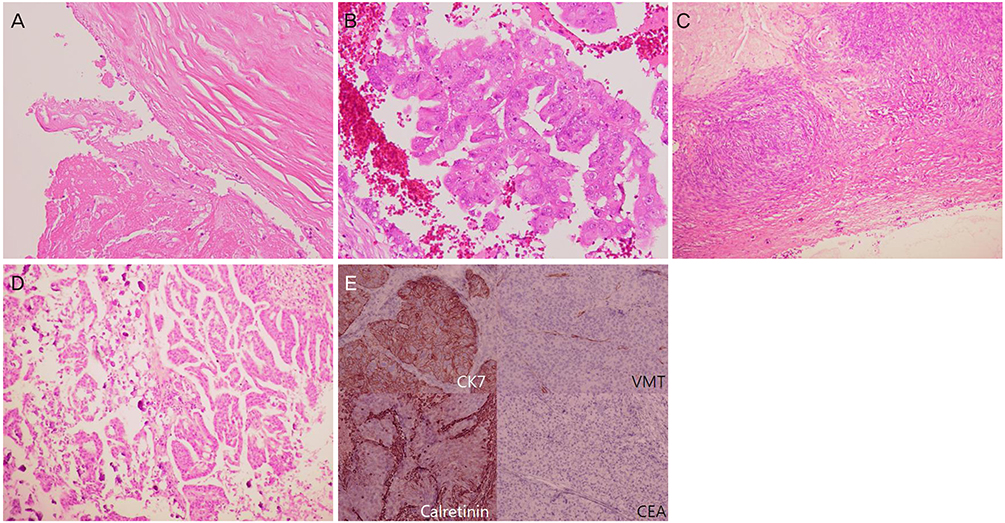Obstet Gynecol Sci.
2015 May;58(3):246-250. 10.5468/ogs.2015.58.3.246.
Primary peritoneal serous papillary carcinoma presenting as a large mesenteric mass mistaken for ovarian cancer: a case of primary peritoneal carcinoma
- Affiliations
-
- 1Department of Obstetrics and Gynecology, Busan St. Mary's Hospital, Busan, Korea. kdbaik@hanmail.net
- 2Department of Pathology, Busan St. Mary's Hospital, Busan, Korea.
- KMID: 2148938
- DOI: http://doi.org/10.5468/ogs.2015.58.3.246
Abstract
- Peritoneal origin serous papillary carcinoma is an uncommon primary malignancy occurring in the abdominal or pelvic peritoneum lining. It is characterized by peritoneal carcinomatosis with massive ascites, uninvolved or minimally involved ovary, and is histologically indistinguishable from ovarian serous tumors. Better recognition of this phenomenon in recent years has contributed to an increasing diagnostic frequency. We describe a rare case of peritoneal origin serous papillary carcinoma with unusual clinical presentations involving a solitary primary tumor originating from the peritoneal lining of the sigmoid colonal mesentery, without pelvic lymph node involvement or distant metastasis. Because of the location and morphological similarity, it was misdiagnosed as an ovarian malignancy. We aim to assist in the diagnosis of this disease with the following case report, thereby improving the management of patients with this condition.
MeSH Terms
Figure
Reference
-
1. Sehgal S, Agarwal R, Goyal P, Singh S, Kumar V, Gupta R. Primary serous carcinoma of peritoneum: a case report. Int J Case Rep Images. 2012; 3:16–20.2. Eltabbakh GH, Piver MS. Extraovarian primary peritoneal carcinoma. Oncology. 1998; 12:813–819.3. Truong LD, Maccato ML, Awalt H, Cagle PT, Schwartz MR, Kaplan AL. Serous surface carcinoma of the peritoneum: a clinicopathologic study of 22 cases. Hum Pathol. 1990; 21:99–110.4. Mills SE, Andersen WA, Fechner RE, Austin MB. Serous surface papillary carcinoma: a clinicopathologic study of 10 cases and comparison with stage III-IV ovarian serous carcinoma. Am J Surg Pathol. 1988; 12:827–834.5. Fromm GL, Gershenson DM, Silva EG. Papillary serous carcinoma of the peritoneum. Obstet Gynecol. 1990; 75:89–95.6. Mulhollan TJ, Silva EG, Tornos C, Guerrieri C, Fromm GL, Gershenson D. Ovarian involvement by serous surface papillary carcinoma. Int J Gynecol Pathol. 1994; 13:120–126.7. Chu CS, Menzin AW, Leonard DG, Rubin SC, Wheeler JE. Primary peritoneal carcinoma: a review of the literature. Obstet Gynecol Surv. 1999; 54:323–335.8. Zissin R, Hertz M, Shapiro-Feinberg M, Bernheim J, Altaras M, Fishman A. Primary serous papillary carcinoma of the peritoneum: CT findings. Clin Radiol. 2001; 56:740–745.9. Lauchlan SC. The secondary Müllerian system. Obstet Gynecol Surv. 1972; 27:133–146.10. Kannerstein M, Churg J, McCaughey WT, Hill DP. Papillary tumors of the peritoneum in women: mesothelioma or papillary carcinoma. Am J Obstet Gynecol. 1977; 127:306–314.11. Lele SB, Piver MS, Matharu J, Tsukada Y. Peritoneal papillary carcinoma. Gynecol Oncol. 1988; 31:315–320.12. Chen KT, Flam MS. Peritoneal papillary serous carcinoma with long-term survival. Cancer. 1986; 58:1371–1373.13. Bloss JD, Brady MF, Liao SY, Rocereto T, Partridge EE, Clarke-Pearson DL, et al. Extraovarian peritoneal serous papillary carcinoma: a phase II trial of cisplatin and cyclophosphamide with comparison to a cohort with papillary serous ovarian carcinoma-a Gynecologic Oncology Group Study. Gynecol Oncol. 2003; 89:148–154.14. Eltabbakh GH, Werness BA, Piver S, Blumenson LE. Prognostic factors in extraovarian primary peritoneal carcinoma. Gynecol Oncol. 1998; 71:230–239.15. Barakat RB, Markman M, Tandall ME. Primary peritoneal carcinoma. Principles and practice of gynecologic oncology. 15th ed. Philadelphia(PA): Lippincott Williams & Wilkins;2009. p. 810–813.



